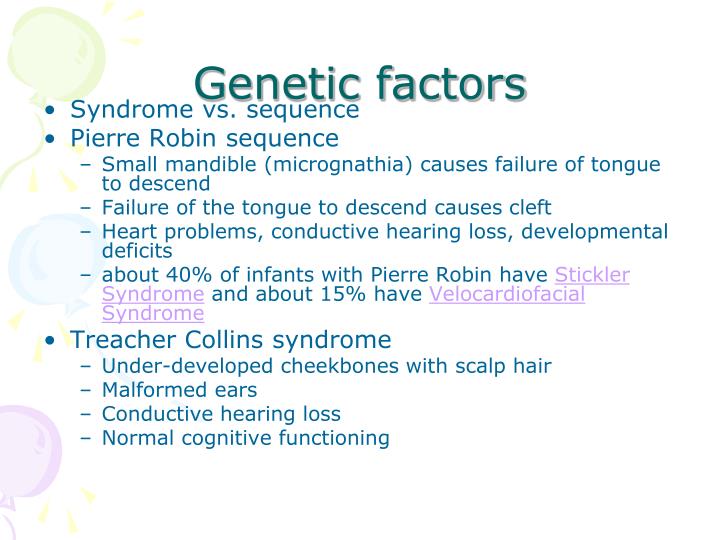

Infants with this condition should NOT be put on their back, to prevent the tongue from falling back into the airway. Pierre Robin sequence and Treacher Collins hypoplastic.
#Pierre robin sequence vs treacher collins full
Living & ManagingĬhildren affected with PRS usually reach full development and size. Also known as Treacher Collins syndrome is a craniofacial disorder. Surgery will be needed to repair the cleft palate and this is done between 9 and 12 months of age, depending on the overall health of the child. In rare cases, patients need surgery to make a hole in the windpipe (tracheostomy) because the breathing problems are so severe. This is often done by distraction osteogenesis of the lower jaw, which stretches the tissue and grows new bone to make a larger jaw. Pierre Robin sequence (PRS also known as Robin sequence, Robin complex, Pierre Robin syndrome, Pierre Robin triad, or Robin anomalad) is a constellation of. In severe cases, surgery is needed to prevent a blockage in the upper airway.

In moderate cases, the patient will need to have a tube placed through the nose and into the airways to avoid airway blockage. If there is evidence of airway obstruction (snorting breathing, apnea, difficulty taking a breath, or drops in oxygen), then the infant should be placed in the side or prone position, which helps bring the tongue base forward in many children. The goal of treatment is to focus on breathing and feeding, and optimizing growth and nutrition despite the predisposition for breathing difficulties. Treatment & CareĪ multidisciplinary team approach is highly recommended for proper management of PRS. A CT scan and sleep study may be required. Consulting with a genetic specialist can rule out other problems linked to this syndrome.Ī diagnosis is made by precise physical examination of the infant, generally right after birth. There’s no specific diagnostic test for PRS. Incomplete closure of the roof of the mouth (cleft palate) is present in the majority of patients, and is commonly U-shaped tongue that is large compared to the jaw Diagnosis & Tests Posterior displacement or retraction of the tongue (glossoptosis), which may cause upper airway obstruction.An unusual small lower jaw (micrognathia).This typically results in a wide U-shaped cleft of the soft and part of the hard palate. However, in PRS the small mandible keeps the tongue positioned higher in the mouth than normal, thereby interfering with the normal closure of the palate. This allows space for the sides of the palate to shift to the midline and close. Normally, between 9 to 11 weeks of gestation, the tongue moves down and away from the roof of the mouth. In addition, some studies demonstrate there may be genetic anomalies at chromosomes 2, 11 or 17. Certain neurological conditions, which lead to decreased jaw movement in utero, can also restrict jaw growth. It is believed that any external factor crowds the fetus and interferes with the growth of the lower jaw. Causes & Risk FactorsĪn exact cause of PRS is not known. Patients can be seen by Texas Children's experts in Plastic Surgery. The condition is called a sequence because it is believed the underdeveloped mandible begins a sequence of events, which leads to the abnormal displacement of the tongue and subsequent formation of a cleft palate. PRS may occur in isolation, but it is can be part of an underlying disorder or syndrome.

There is a higher incidence in twins, which may be due to crowding in the uterus, restricting growth of the mandible (lower jaw). This condition occurs in approximately 1 in 8,500 to 14,000 births, and it’s equally common in males and females. glossoptosis (airway obstruction caused by backwards displacement of the tongue base).severe underdevelopment of the lower jaw (retrognathia) Pierre Robin syndrome, increasingly known as the Robin sequence or Pierre Robin sequence, comprises the triad of micrognathia, glossoptosis, and obstructive.cleft palate (opening in the roof of the mouth).The three main features that characterize PRS are: Zackai, Elaine H.Pierre-Robin Syndrome (PRS), also known as Pierre Robin sequence, is a congenital condition that affects the lower jaw and palate. Sheikh, Farah Sherman, Randy Sie, Kathleen C.Y. Sell, Debbie Semb, Gunvor Shaw, William C. Mazaheri, Mohammad McDonald-McGinn, Donna M. Lee, Seng-Teik Lee, Shu-Jin Leslie, Elizabeth J. Steve Campbell, Alex Chen, Philip Kuo-Ting Chen, Yu-Ray Chibbaro, Patricia Daly Chong, David K.


 0 kommentar(er)
0 kommentar(er)
